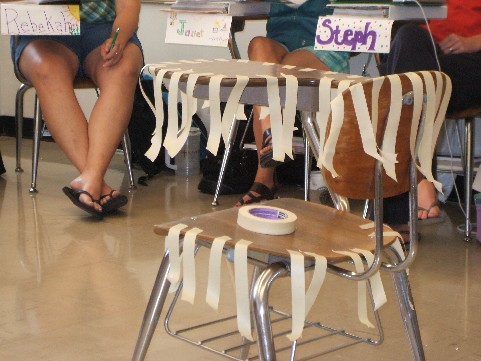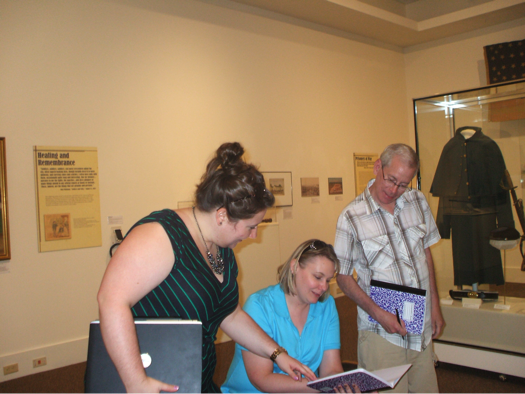
Eastern Illinois Writing Project Lessons to Share
Eastern Illinois Writing Project Share Folder:
Please add and view resources here!
2021 Summer Institute I-Search Papers
2020 Summer Institute I-Search Papers
2019 Summer Institute I-Search Papers
2018 Summer Institute Lessons and Creative Work
2016 Summer Institute Lessons and Creative Work
4. Technology Tools from Summer 2016!
2015 Summer Institute Lessons and Creative Work
1. Demonstration Anthology pdf
2. Creative Writing Anthology pdf
2014 Summer Institute Lessons and Creative Work
1. Demonstration Anthology pdf
2. Creative Writing Anthology pdf
2013 Summer Institute Lessons and Creative Work
1. Demonstration Anthology pdf
2. Creative Writing Anthology pdf
2012 Summer Institute Lessons and Creative Works
1. Demonstration Anthology pdf
2. Creative Writing Anthology pdf
2011 Summer Institute Lessons and Creative Works
1. Demonstration Anthology pdf
2008-2010 Summer Institutes Lessons and Creative Works
2. Creative Writing Anthology pdf
6. Miscellaneous Anthology pdf
Lincoln Log Cabin Writing Crawl
By Duane Huffman
The walking by farms, fields, and gardens - they remind me of my Hoosier childhood. From the 3rd grade, just after John F. Kennedy was assassinated, we moved from the city of Muncie to an old farmhouse with twenty-two acres. I remember the frequent chores, cattle, pigs, chickens, the manure that goes with all of the aforementioned, and gardening. So close to nature! When my parents decided the first crop would be oats, I didn’t know how we could possibly eat that much oatmeal! A hand pump water well on the back porch, an outhouse, and a galvanized tub for bathing are vivid, but difficult memories.
How could they?
I can never forget.
Will I ever forgive?
SONG: Take Me Home, Country Roads
Almost heaven, Indiana,
Rolling hillsides, Ohio valley.
Land of my childhood,
Walking pathways,
Hay fields calling,
A Hoosier here I come.
CHORUS: Country roads,
Take me home,
To a place where I belong.
Indiana, now Illinois,
Take me home,
Country roads.
Tarble and Doudna Fine Arts Centers Writing Crawl

One of the best ways we have found to encourage creative writing is to leave the classroom with journals (and sometimes tablet or laptop) in hand and respond to a new setting and set of experiences.
This summer we explored the Doudna Arts Center and Tarble Arts Center, the Lincoln Log Cabin, and the Charleston Square for half day crawls. Our last crawl was an all-day adventure in Sullivan. We started in the cemetery and then ended up on Carol and DJ Smith’s Houseboat. Thank you, Carol and DJ!

Teaching Demonstrations
Duane Huffman
EIWP 2013
Benjamin Franklin and Poor Richard’s Almanac
Text reading, speaking, listening, and writing
1. Overview: Students will read text and respond with comprehension. They will interpret aphorisms, comparing and contrasting previous wisdom with current understanding. Carousel brainstorming in groups will create information for a summary. Students will study a primary source for additional questions answerable by digital research.
2. Rationale: The current Common Core Standards encourage more rigorous reading, speaking, intent listening, and additional writing experiences, formal and informal.
3. Learning Objectives: The purpose is to go beyond the current Social Studies textbook (United States History, Harcourt HORIZONS, 2006) and explore more background information on Benjamin Franklin’s Poor Richard’s Almanac. Also a link to meanings past and present of witty sayings will be integrated with group work, culminating in a summary. Students will also be prompted to explore questions about the primary source that can be explored in class or on their own.
Common Core Standards
CCSS.ELA-Literacy.RL.5.1 Quote accurately from the text when explaining what the text says explicitly and when drawing inferences from the text.
CCSS.ELA-Literacy.SL5.1.b Engage effectively in a range of collaborative discussions(one-on-one, in groups, and teacher-led) with diverse partners on grade 5 topics and texts, building on others’ ideas and expressing their own clearly. (b- Follow agreed-upon rules for discussions and carry out assigned roles.
CCSS.ELA-Literacy.W5.2.c Write informative/explanatory texts to examine a topic, and convey ideas and information clearly. (c- Link ideas within and across categories of information using words, phrases, and clauses (e.g., in contrast, especially)
4. Materials:
Copies of Robert Byrd’s Electric Ben, pages 13-14
Poster paper
Markers
Writing paper and pen
5. Procedure:
a. Students will work in pairs to read pg. 13 of Electric Ben: both students will silently read, but after reading, the strategy will be for one student to be the listener, the other to be the teller, and then together, with their partner, they will check for accuracy. Students can read half of the page and check, then the other half, switching roles.
b. Discussion of the results is next, for further comprehension of the material.
c. The “Almanack” page will now be viewed. The aphorisms (proverbs, witty sayings, sayings which give advice, but not meant to be taken literally, literal vs. figurative)are also posted on the wall posters around the room for carousel brainstorming of meaning, both past and present, being mindful of comparing and contrasting information.
d. The partners will move to the wall posters with markers and begin brainstorming, moving from poster to poster, writing comments and reflections on each.
e. After viewing and writing on all of the posters, students will return to their seats to write a summary (reflection) of the poster of their choice, or one poster will be assigned to each pair. The words (e.g.), in contrast and especially will be stressed for usage.
f. Time to share summaries will be given to volunteers.
g. In the middle of page 14, are many items of interest. Students need to write down questions that they would like to have answered in the near future. At this time, questions can be discussed, written for public viewing, or instantly investigated through the internet for possible answers.
6. Evaluation:
Teacher can informally evaluate participation in the carousel brainstorming activity. Each student should produce an informal summary (reflection) at the end. Students can even be required to produce an Exit Slip question before departure.
7. Extension:
Assign a biographical poster about Benjamin Franklin enlisting books and/or internet searches.
Use Exit Slips at the end to prompt questions about the middle text.
Students can pair up to read and share each paragraph, so that as the end, all paragraphs have been shared openly in the classroom forum. (Zigzag method)
Many more aphorisms can be explored, as published by Benjamin Franklin.
Sources:
Byrd, Robert. Electric Ben, New York, NY: Dial Books for Young Readers, 2012.
Daniels, Harvey, Steven Zemelman, and Nancy Steineke. Content-Area Writing: Every Teacher’s Guide.Portsmouth, NH: Heinemann, 2007.

Carlene Weber
EIWP 2013
Demo Lesson
Graphing Inequalities Writing Assignment
Lesson: Graphing Inequalities (after students have learned how to graph equations of lines)
Grade Level: 9th and 10th graders Class Length: 50 minutes
Rationale: Teachers, according to Thaiss and Suhor, “have realized that students learn science – or math, history, or any other discipline – by talking about it and writing about it, as well as by reading texts and hearing others talk. These teachers apply to practice what researchers in different fields have been preaching for many years: Learning happens when you or I use our perceptions (e.g. through reading or listening) to solve problems important to us, and try to put those perceptions into words (spoken or written) so that others can use them and so that we ourselves will understand them” (1).
This activity is an example how students learn a concept in a math classroom by first listening, then modeling, and then writing about the procedure to enhance their understanding of the concept.
Objective: Students will graph inequalities on a Cartesian Rectangular plane and then put in writing the procedure they used to find the solution. Afterwards, they will trade papers and solve other inequality problems by using the explanation of their partners.
Standards:
A.REI.12 Graph the solutions to a linear inequality in two variables as a half-plane (excluding the boundary in the case of a strict inequality), and graph the solution set to a system of linear inequalities in two variables as the intersection of the corresponding half-planes.
A.REI.1 Explain each step in solving a simple equation as following from the equality of numbers asserted at the previous step, starting from the assumption that the original equation has a solution. Construct a viable argument to justify a solution method.
Materials:
Overhead projector and document camera
Blank graphing paper (Cartesian Rectangular planes)
Pencils / colored pencils
Rulers or straight edges
Handouts – inequality problem and explanation sheets
Activities / Procedures
1.) Instructor will review the procedure of graphing equations of lines.
2.) Instructor will model the procedure of graphing a system of inequalities.
3.) Instructor will hand out the necessary materials to the students.
4.) Instructor will lead the class in graphing a couple of problems with inequalities.
5.) Instructor will then hand out problem sheets to students to work.
6.) Students will simultaneously write down the steps and graph the inequality problem that they were given.
7.) Once finished, students will use the second sheet to write a procedure explaining how to graph their given inequality. (They are not allowed to state the original inequalities in their procedure.)
8.) Students will then exchange their papers with a partner. Using only their partner’s written procedure, students are to graph a new system of inequalities and then write the system.
Assessment:
Students will be assessed using the following criteria:
1.) Is the graph of the system of inequalities correct?
2.) Do the steps for the procedure include all necessary steps?
3.) Does the written procedure include all necessary steps? (i.e. Was your partner able to read your procedure and then correctly graph the solution set?)
Adaptations and Modifications:
1.) Students with learning disabilities may only have to solve and write one of the inequalities (instead of both) or they may be partnered with a gifted student who can help them.
2.) Students could be paired at the very start solving and writing together.
3.) This type of writing assignment could be used in almost any curricular area. Once students have learned a new procedure, they can then write the steps before writing a procedure in paragraph form.
Extensions:
1.) Have students graph the inequalities on a graphing calculator to check their solution sets.
2.) Students could work problems that involve more than 2 inequalities. For example, many optimization problems involve 4-5 inequalities.
Resources:
Thaiss, Christopher, & Suhor, Charles. Speaking and Writing, K-12. Urbana, IL: National Council of Teachers of English, 1984. Print.
